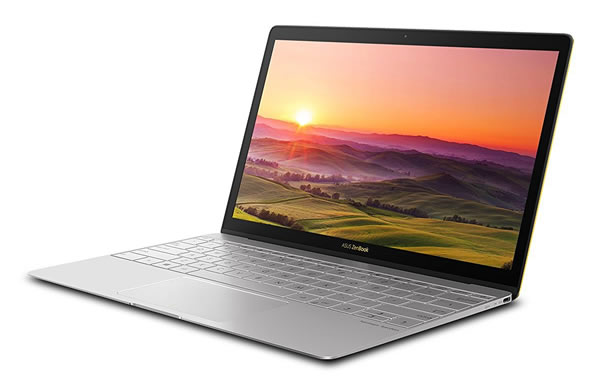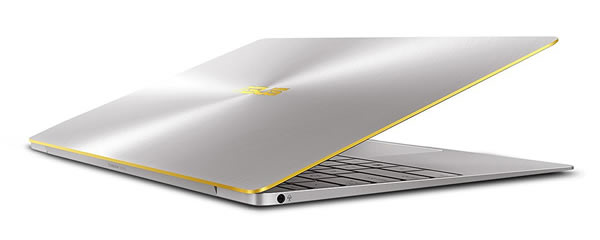The latest generation of ZenBook ultrabooks is a triumph of design and user-centric experience. This flagship device is the Taiwanese manufacturer’s latest proof of market domination. It looks better than most premium notebooks you can buy today and is, above all, a style statement. Today I’ve picked the ASUS ZenBook 3 UX390UA-DH51-GR model to review.
Review
With the legacy of previous generations in mind, the ZenBook 3 marks a significant step forward in terms of innovation, mostly of which revolves around making the notebook slimmer. And as I said earlier, the ZenBook is a statement above everything else. There are more powerful and more portable ultrabooks, but none of them have the same panache vibe going.

Following the mantra of incremental innovations set by Apple, this model is a step forward from the previous generation. You can’t argue with the numbers, and the ASUS UX390UA-DH51-GR has them on its side. It’s just 0.47 inches slim, weighs only 2.1 pounds and boasts a 0.3-inch wide screen bezel.
However, as we’ll discover later, the ZenBook 3 does suffer from what can only be called as “too much of a good thing”. After all, buying a premium ultrabook means taking a decision that’s also based on other factors, such as usability and performance. And it’s usability and user-friendliness where the ZenBook 3 is lacking, at least in my opinion.
As expected from the looks of it, the building quality and materials are top notch. The ASUS UX390UA-DH51-GR is built from “aerospace-grade” aluminum, which is lighter and more resistant. Also, the display is coated with a layer of Corning Gorilla Glass 4. Therefore, the ZenBook 3 does appear to be as sturdy as a lightweight notebook can get.
Performance
Under that impossibly thin chassis we find a rather standard assortment of hardware equipment, and when I say standard, I’m thinking of mid-range classic laptops in the $600-$800 price range. So, by adding the stylish exterior to the comparable insides, I think the $1100 price (as of 11/1/2016) is well justified.
Starting with the processor, we see that the ASUS ZenBook 3 UX390UA-DH51-GR comes with a 7th generation Intel Core i5-7200U CPU. This 2.5 GHz Intel can go up to 3.1 GHz and has a cache size of 3 megabytes. If you ask me, that is a perfectly adequate processor to work with, save from some really, really intensive tasks. It will handle everything from your daily usage to photo & video editing, 3D rendering and even running VM software and coding (for power users).
System memory is also sufficient for everything to run perfectly smooth on Windows 10. It comes with 8 gigabytes of LPDDR3-2133 RAM. Memory can not be upgraded unfortunately because of the slim nature of the device, it being soldered to the mother board. If you need more, you can opt for the (much) more expensive [easyazon_link identifier=”B01LHUAFAQ” locale=”US” tag=”laptop0b2-20″]16GB model[/easyazon_link]. Still, the 8 gigs will handle large data sets, extreme multitasking, loads of opened browser tabs and more without ever having to experience system freeze.
The ASUS UX390UA-DH51-GR has a 256-gigabyte SSD installed. Again, this number is relative to your specific needs and wants. I’d argue that it’s enough for many, if not most users, since more and more of our previously locally stored libraries are being moved online.
This, more affordable model, comes with a SATA3 SSD, but the more expensive one has a much faster (up to 3 times faster) PCIE Gen3 SSD. It also has twice the storage capacity.
This is where the gap between the two models ends. To recap, a $450 price hike gets you an Intel i7 CPU, 16 GB of RAM and 512 GB of storage space. Is the price difference worth it? Barely, but if you’re looking for a more potent version of the stunning ZenBook, it may be worth it.
Graphics and display
The ASUS UX390UA-DH51-GR comes with an integrated video card, the Intel HD Graphics 620 model. Some light gaming will definitely be achievable, while tasks such as photo editing or working with design software won’t put much stress on the system, except for the most intense of tasks. However, for the vast majority of users, this graphics card won’t struggle with day-to-day computing.

Read user reviews at Amazon.com »
A stunning 12.5 inch LED-backlit IPS FHD glare display is available for both the cheap and the expensive models. To be honest, I would have expected a QHD+ display to be mounted on the flagship variant, like Dell has opted to do for their XPS series. This addition would have made the price increase more justified.
Still, the IPS panel that is used with the ZenBook produces a resolution of 1920 x 1080 pixels, 178-degree viewing angles, 78% NTSC color gamut and an impressive 1000:1 contrast ratio.
Interface and networking options
Remember what I’ve said in the beginning of this article about the ZenBook’s drawbacks? We’ve reached one of them. While many modern devices are cautious when jumping on the bandwagon of new technologies, the ASUS ZenBook 3 UX390UA-DH51-GR has gone above and beyond. It has just one port. One USB-C port in which you either plug in a single device or a clunky universal dock, which is sold separately, of course.
It baffles the mind how carrying a dock is seen and marketed as “next level”, but that’s the reality right now. If it were equipped with two USB-C ports, everything would have been fine, but in my opinion just a single port (even if it supports USB, HDMI, VGA, RJ-45 and SD card reader through an adapter) is limiting.
So, the interface list is quite short:
- 1 x USB-C (supports USB, HDMI, VGA, RJ-45, card reader)
- 1 x COMBO audio jack
The networking aspect of the ZenBook 3 UX390UA-DH51-GR isn’t controversial, but great. It has a dual band 802.11ac wireless card with built-in Bluetooth 4.0.
Extra features
I’ll start with another minor shortcoming, just to get them out of the way. The backlit keyboard, although beautifully constructed and aesthetic, has a key travel distance of just 0.8mm, almost half of the standard 1.5mm many laptops feature nowadays. Some folks may find it somewhat unresponsive when typing away. This concludes my rant about the ZenBook and usability.

Now, let’s have a look at the rest of the features:
- Innovative cooling – Even if it’s incredibly slim, ASUS have managed to fit a thin enough cooling system inside. The centrally placed fan dissipates heat through the dual copper plates that lead to hidden exhaust vents placed behind the hinges.
- Quad speakers – Superior sound quality is available thanks to four speakers that were designed with the help of Harman Kardon.
- Fingerprint sensor – Using your fingerprint, you can easily unlock the screen with just a swipe of the finger on top of the sensor placed in the upper right corner of the touch pad. This is a native feature of Windows 10 called Windows Hello.
Portability and battery life
As expected from such a slim ultrabook, it’s extremely comfortable to carry around. The 12.5″ ZenBook 3 weighs just 2 pounds, or 910 grams. It’s one of the most lightweight notebooks on the market, rivaling the impressive LG gram in this regard. As a result, it will feel natural to place it in your bag or backpack and hit the road, not having to worry about significantly weighing you down.
The ZenBook’s 6-cell, 40 Whrs polymer battery packs an impressive amount of juice. It’s enough for almost 9 hours of battery life before needing a wall socket. Although more autonomy can be had with other similar ultrabooks, none are quite as thin as the ZenBook UX390UA-DH51-GR, so I think the trade-off is more than fair.

One more thing, the battery supports fast charging, meaning it will charge from 0 to 60% in 50 minutes.
Final words
It’s hard for me to decide whether the ASUS ZenBook 3 UX390UA-DH51-GR is a notebook worth buying or not. There are other alternatives, with some offering more value for money. However, I don’t think any of them are as iconic as the ZenBook. This is much more than your average featherweight device. It’s both a statement and a philosophy, where form and design take the center stage.
It’s a great option to consider for traveling executives, light backpackers and not only. Its simplicity and timelessness rivals that of Apple’s notebooks, so I’m sure anyone will find the ZenBook 3 one of the most appealing ultrabooks on sale today.




